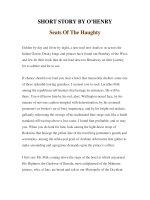Cancer of the Testis ppt
Bạn đang xem bản rút gọn của tài liệu. Xem và tải ngay bản đầy đủ của tài liệu tại đây (457.59 KB, 6 trang )
National Cancer Institute 165 SEER Survival Monograph
INTRODUCTION
Testicular cancer is a relatively rare cancer, with an es-
timated 8,250 new cases diagnosed in U.S. men in 2006
(1). Despite the fact that it accounts for only 1% of all
malignancies in males, it is the most common malignancy
in men aged 20-34, and in the U.S. and most western
countries the incidence has more than doubled since the
1940s (2,3). Survival of patients with testicular, particularly
those with metastatic disease, has improved significantly
since the early 1970’s as the result of the development
and wide-spread use of cisplatin-containing combination
chemotherapy. The 5-year survival rate for testicular cancer
patients, including all stages, was 72% in 1970-1973, and
91% for patients diagnosed in 1983-1985 (4). For men di-
agnosed with testicular cancer during 1992-1998, the 5-yr
survival rate was 95% (4), and today, testicular cancer is
considered one of the most curable solid neoplasms (5).
MATERIALS AND METHODS
There were 12,978 adult cases of testicular cancer (other
than testicular lymphomas) diagnosed from 1988 through
2001 and reported to the SEER program. A detailed descrip-
tion of the source of these data is given in the introductory
chapter of this monograph. Table 21.1 shows the numbers
of cases excluded from the present analysis, by reason.
This chapter describes survival analysis of the remaining
11,606 histologically confirmed, first primary cases of
adult testicular cancer diagnosed from 1988 through 2001
and reported to the SEER Program.
Histologic Classication
Germ cell carcinomas comprise the overwhelming major-
ity (98.9%) of adult testicular carcinomas (6). Because
non-germ cell testis tumors are uncommon and comprise
a heterogeneous group, the focus of the analysis was on
germ cell carcinomas. Within the germ cell neoplasms,
tumors can be classified, based on pathologic and clinical
features, into two broad histologic groups: seminomas and
non-seminomas. Seminomas tend to grow more slowly
and are very sensitive to radiation therapy, compared to
non-seminomas which are more clinically aggressive and
do not respond well to radiotherapy (7). Approximately
61% of testicular germ cell carcinomas are pure semi-
nomas with the remainder comprised of non-seminomas
(teratomas, embryonal carcinomas, choriocarcinomas, yolk
sac tumors), and mixtures of two or more types (8). Germ
cell carcinomas were classified using ICD-O-2/ICD-O-3
morphology codes into broad categories of seminoma (ICD
9060-9064) and non-seminoma (ICD 9070-9101), or more
narrowly into specific histologic groups: seminoma (ICD
9060-9064), embryonal carcinoma (ICD 9070), yolk sac
tumor (ICD 9071), teratoma (ICD 9080, 9082-9084), mixed
Mary L. Biggs and Stephen M. Schwartz
Chapter 21
Cancer of the Testis
Table 21.1: Cancer of the Testis: Number of Cases and Exclusions by Reason, 12 SEER Areas, 1988-2001
Number Selected/Remaining
Number
Excluded
Reason for Exclusion/Selection
12,978 0 Select 1988-2001 diagnosis (Los Angeles for 1992-2001 only)
12,528 450 Select first primary only
12,511 17 Exclude death certificate only or at autopsy
12,394 117 Exclude unknown race
12,366 28 Exclude alive with no survival time
11,707 659 Exclude children (Ages 0-19)
11,699 8 Exclude in situ cancers
11,651 48 Exclude no or unknown microscopic confirmation
11,606 45 Exclude sarcomas
Chapter 21 Cancer of the Testis
National Cancer Institute 166 SEER Survival Monograph
germ cell tumor (ICD 9081, 9085, 9101), and choriocar-
cinoma (ICD 9100).
Stage
Testicular cancers are staged within the SEER data using
the categories in situ, localized, regional, distant, and un-
staged. Staging information on the cancer is also contained
within the 10-digit Extent of Disease (EOD) code, which
is based on clinical, operative, and pathologic diagnoses of
the cancer. The EOD code encodes tumor size, extension
of the tumor into surrounding tissues, and lymph node in-
volvement. We used EOD coding to stage tumors accord-
ing to the American Joint Committee on Cancer (AJCC)
classication system, 5th Edition (9). The SEER modi-
ed AJCC stages (5th edition) for testicular cancer are
as follows: Stage I (no spread to lymph nodes or distant
organs), Stage II (the cancer has spread to regional lymph
nodes but not to lymph nodes in other parts of the body
or to distant organs), and Stage III (the cancer has spread
to non regional lymph nodes and/or to distant organs).
We were not able to further subclassify stages (ie., A, B,
C) because substaging relies on serum tumor marker data
which was not collected by the SEER program prior to
1998.
Tumor Size
Information on tumor size is contained within the 10-digit
Extent of Disease (EOD) code. We examined the inu-
ence of tumor size (< 5 cm vs. 5+ cm) on relative survival
among patients diagnosed with Stage I testicular cancer.
Age & Race
To investigate the impact of age at diagnosis on relative
survival, testicular cancer cases were grouped into the
following age groups: 20-29, 30-39, 40-49, 50-59, 60-69,
70+. To examine race-specic survival, patients were clas-
sied into 3 groups: black, white and all (includes blacks,
whites, and all other races).
RESULTS
Table 21.2 shows the frequency of testicular cancer cases
classified by histology and age at diagnosis. Seminomas
comprised the largest histologic group (61.1%). Germ cell
tumors of mixed histologic types comprised the next larg-
est group (23.2%). Non-germ cell and unspecified tumors
comprised 1% of eligible tumors. More than 72% of the
testicular cancer cases were diagnosed between the ages
of 20-39. For men diagnosed with seminomas, the peak
frequency occurred in the 30-39 year age group, while
for men diagnosed with non-seminomas it was among
20-29 year olds.
Three-quarters of all men with testicular carcinomas were
diagnosed in Stage I (Table 21.3). However, the proportion
of tumors diagnosed at early and late stages varied with
the histologic type of the tumor. The largest proportion
of testis tumors diagnosed in Stage I were seminomas
(85.8%). Choriocarcinomas had the smallest proportion
of Stage I tumors (20.7%) and the largest proportion of
Stage III tumors (74.1%).
Overall Survival
Overall, survival among men diagnosed with testicular
cancer was very high. Relative survival rate was 98% at 1
year following diagnosis, 97% at 2 years, 96% at 5 year,
and 95% at 10 years after diagnosis (Table 21.4).
Histology
The relative survival rate varied with the histologic type of
the tumor (Figure 21.1). The highest survival rate was ob-
served for men diagnosed with pure seminomas; 10-year
relative survival was 98. The 10-year relative survival
Table 21.2: Cancer of the Testis: Number and Distribution of Cases by Histology and Age (20+), 12 SEER Areas, 1988-2001
Histology
Age (Years)
Total 20-29 30-39 40-49 50-59 60-69 70+
Cases Percent Cases Cases Cases Cases Cases Cases
Total 11,606 100.0 3,663 4,746 2,329 581 196 91
Germ Cell 11,480 98.9 3,639 4,710 2,307 563 183 78
Seminomas 7,086 61.1 1,471 3,137 1,802 455 153 68
Non-seminomas 4,394 37.9 2,168 1,573 505 108 30 10
Embryonal 1,315 11.3 624 479 164 36 8 <5
Yolk Sac 126 1.1 56 46 17 <5 <5 <5
Teratoma 203 1.7 117 62 21 <5 0 <5
Mixed Germ Cell 2,692 23.2 1,344 968 294 65 17 <5
Choriocarcinoma 58 0.5 27 18 9 <5 <5 0
Non-Germ Cell and Unspecified 126 1.1 24 36 22 18 13 13
Chapter 21 Cancer of the Testis
National Cancer Institute 167 SEER Survival Monograph
rate for non-seminomas was lower, 91% (Table 21.4), but
varied by histologic type from 46% for choriocarcinoma
to 92% for embryonal tumors and mixed germ cell tumors
(Figure 21.1).
Stage and histology
Testicular cancer relative survival decreased with increas-
ing stage at diagnosis. Ten-year relative survival rates
were over 95% for both Stage I and Stage II. When com-
paring tumors diagnosed at the same stage, survival rates
for seminomas and non-seminomas were similar, with the
exception of tumors diagnosed at Stage III (Table 21.4).
Among men diagnosed with advanced disease, those
diagnosed with seminomas had substantially better 2-, 3-,
5-, 8-, and 10- year survival rates than men diagnosed with
non-seminomas.
Tumor size
Relative survival of patients diagnosed with Stage I
testicular cancer was higher for those with tumors smaller
than 5 cm compared to patients diagnosed with tumors
that were 5 cm or larger (Table 21.5). Size accounted for
more of a survival difference for non-seminomas than
seminomas, but 10-year survival rates were over 92%
even for non-seminomas 5 cm and over.
Age at Diagnosis
Among men diagnosed with seminomas, those aged 20-49
had similar, though slightly higher, survival to those over
50 years (Fig. 21.2). Among men with non-seminomas,
the difference in survival between the two age groups was
more pronounced: 2-year survival rate was 95% in the
younger age group versus 84% in the older one; 5-year
survival rate was 93% in the 20-49 age group versus 79%
in those over 50 years of age. The distribution of stage
at diagnosis of testicular tumors was similar among men
aged 20-49 and those aged 50+ (results not shown).
Race
For seminomas, survival was slightly less among black
men than among white men (Fig. 21.3). The disparity was
more marked among men diagnosed with non-seminomas;
5-year relative survival rate was 93% among white men
diagnosed with non-seminomas compared to 75% among
black men. The distribution of specic histologic types did
not vary appreciably by race (results not shown).
Race and Stage
Black men were more likely to be diagnosed with higher
stage germ cell carcinomas compared to white men (Table
21.6). For any given stage, the relative survival rate among
black men was poorer than survival rate among white men
(Table 21.7). The racial disparity was most pronounced
among patients diagnosed in Stage III; 5-year relative
survival rate among white men was 75% compared to 58%
among black men. Black men had larger tumors, on aver-
age, than white men diagnosed at the same stage (results
not shown).
DISCUSSION
Overall, the survival rates for patients diagnosed with
testicular cancer during 1988-2001 was excellent, with
95% surviving 10 years. Improvements in treatment, the
most dramatic resulting from the introduction of cisplatin-
containing combination chemotherapy in the 1970’s, have
Table 21.3: Cancer of the Testis: Number and Distribution of Cases by Histology and AJCC Stage (SEER modified 5th Edition),
Ages 20+, 12 SEER Areas, 1988-2001
Histology
AJCC Stage
Total I II III Unknown/
Unstaged
Cases Percent Cases
Row
Percent Cases
Row
Percent Cases
Row
Percent Cases
Row
Percent
Total 11,606 100.0 8,847 76.2 1,343 11.6 1,214 10.5 202 1.7
Germ Cell 11,480 100.0 8,781 76.5 1,340 11.7 1,175 10.2 184 1.6
Seminomas 7,086 100.0 6,077 85.8 507 7.2 393 5.5 109 1.5
Non-seminomas 4,394 100.0 2,704 61.5 833 19.0 782 17.8 75 1.7
Embryonal 1,315 100.0 728 55.4 339 25.8 226 17.2 22 1.7
Yolk Sac 126 100.0 72 57.1 18 14.3 34 27.0 <5 1.6
Teratoma 203 100.0 145 71.4 27 13.3 24 11.8 7 3.4
Mixed Germ Cell 2,692 100.0 1,747 64.9 449 16.7 455 16.9 41 1.5
Choriocarcinoma 58 100.0 12 20.7 0 0.0 43 74.1 <5 5.2
Non-Germ Cell and
Unspecified 126 100.0 66 52.4 <5 2.4 39 31.0 18 14.3
Chapter 21 Cancer of the Testis
National Cancer Institute 168 SEER Survival Monograph
Figure 21.1: Cancer of the Testis: Relative Survival Rates (%)
by Histology, Ages 20+, 12 SEER Areas, 1988-2001
Figure 21.2: Cancer of the Testis: Relative Survival Rates (%)
Histology and Age Group (20+), 12 SEER Areas, 1988-2001
0
10
20
30
40
50
60
70
80
90
100
0 12 24 36 48 60 72 84 96 108 120
Relative Survival Rate (%)
Months after diagnosis
Seminomas Embryonal
Mixed Germ Cell Yolk Sac
Teratoma Choriocarcinoma
Non-Germ Cell & Unspecified
0
10
20
30
40
50
60
70
80
90
100
0 12 24 36 48 60 72 84 96 108 120
Relative Survival Rate (%)
Months after diagnosis
Seminomas,
20-49
Seminomas,
50+
Non-seminomas,
20-49
Non-seminomas,
50+
Table 21.5: Stage I Germ Cell Carcinoma of the Testis: Number of Cases and 1-, 2-, 3-, 5-, 8-, & 10-Year Relative
Survival Rates (%) by Histology and Tumor Size, Ages 20+, 12 SEER Areas, 1988-2001
Relative Survival Rate (%)
Histology/Tumor Size Cases 1-Year 2-Year 3-Year 5-Year 8-Year 10-Year
All Germ Cell 8,781 99.8 99.4 99.0 99.0 98.6 98.5
< 5 cm 5,166 100.0 99.8 99.8 99.8 99.8 99.8
5+ cm 2,321 99.6 98.8 97.9 97.6 96.8 96.4
Unknown 1,294 99.3 98.4 97.3 97.0 96.0 95.5
Seminomas 6,077 100.0 99.7 99.5 99.5 99.4 99.4
< 5 cm 3,497 100.0 100.0 100.0 100.0 100.0 100.0
5+ cm 1,671 99.8 99.3 98.6 98.4 97.9 97.8
Unknown 909 99.4 98.9 98.3 98.1 96.9 96.6
Non-seminomas 2,704 99.5 98.5 97.8 97.5 96.8 96.5
< 5 cm 1,669 99.7 99.2 99.1 99.1 98.9 98.9
5+ cm 650 99.1 97.6 96.0 95.3 93.0 92.4
Unknown 385 98.8 97.3 95.0 94.0 93.7 92.5
Table 21.4: Germ Cell Carcinoma of the Testis: Number of Cases and 1-, 2-, 3-, 5-, 8-, & 10-Year Relative Survival Rates (%) by
AJCC Stage (SEER modified 5th Edition) and Histology, Ages 20+, 12 SEER Areas, 1988-2001
AJCC Stage/Histology Cases
Relative Survival Rate (%)
1-Year 2-Year 3-Year 5-Year 8-Year 10-Year
Total 11,480 98.2 96.8 96.2 96.0 95.4 95.3
Seminomas 7,086 99.0 98.4 98.1 98.0 97.7 97.7
Non-seminomas 4,394 96.8 94.2 93.2 92.6 91.8 91.3
Stage I 8,781 99.8 99.4 99.0 99.0 98.6 98.5
Seminomas 6,077 100.0 99.7 99.5 99.5 99.4 99.4
Non-seminomas 2,704 99.5 98.5 97.8 97.5 96.8 96.5
Stage II 1,340 98.5 97.0 96.5 96.1 95.5 95.2
Seminomas 507 98.4 96.8 96.3 95.9 95.1 95.1
Non-seminomas 833 98.5 97.1 96.6 96.0 95.7 94.9
Stage III 1,175 85.8 78.1 75.3 74.0 71.5 71.1
Seminomas 393 85.9 81.9 79.3 78.5 75.2 74.7
Non-seminomas 782 85.7 76.2 73.3 71.7 69.7 68.7
Unknown/Unstaged 184 97.4 94.9 93.9 93.1 93.1 93.1
Seminomas 109 96.5 94.0 93.2 93.2 93.2 93.2
Non-seminomas 75 98.7 96.2 95.0 92.2 92.2 92.2
Chapter 21 Cancer of the Testis
National Cancer Institute 169 SEER Survival Monograph
led to improved survival and declining mortality over
the past 30 years (5).
Survival of patients with testicular cancer varied by the
histologic type of the tumor, and differences in stage at
diagnosis are likely to have contributed to this variation.
Patients diagnosed with pure seminomas (predominantly
diagnosed in Stage I) had the best survival; 10-year survival
was 98%. Compared to those with seminomas, patients
diagnosed with non-seminomas tended to be diagnosed
with a more advanced stage of disease and had poorer
survival, reflecting the more clinically aggressive nature
of non-seminomas. Patients diagnosed with choriocarci-
nomas (largely diagnosed in Stage III) had the poorest
survival.
Among non-seminoma testicular cancer patients diagnosed
at Stage I, tumor size was related to survival. Patients
diagnosed with tumors smaller than 5 cm experienced
better relative survival than those diagnosed with tumors
that were 5 cm or larger. For Stage I non-seminomas,
the five-year survival among those with smaller tumors
(< 5 cm) was 99% compared to 95% for patients diagnosed
with larger tumors ( 5+ cm).
The age at diagnosis of testicular cancer had an impact on
survival, particularly among men diagnosed with non-sem-
inomas. Men diagnosed with non-seminomas between the
ages of 20 and 49 had a 5-year survival of 93%, compared
to 79% for those aged 50 and above. Stage at diagnosis
was similar between younger and older men and could
not account for the difference in survival observed.
Testicular cancer survival also depended on the race of
the patient, with black men experiencing poorer survival
than white men. The differences in race-specific survival
were partially explained by disease stage at diagnosis;
compared to whites, a higher proportion of black men
were diagnosed with advanced-stage disease. However,
even when comparing men diagnosed at the same stage,
survival was worse among black men compared to white
men. The disparity in survival was particularly apparent
among patients diagnosed with Stage III cancer; 5-year
survival among men diagnosed with Stage III testicular
cancer was 75% in white men compared to 58% in black
men. The survival differential may be related to the larger
average tumor size in black men, reflecting more advanced
disease not captured in the 3-category staging classifica-
tion that we used. Using these data, we were unable to
explore the possible reasons for black men presenting
with more advanced disease, nor whether this fully ac-
counted for the survival differential between black and
white testicular cancer patients.
Table 21.6: Germ Cell Carcinoma of the Testis: Number and
Distribution of Cases by AJCC Stage (SEER modified 5th
Edition) and Race, Ages 20+, 12 SEER Areas, 1988-2001
AJCC
Stage
Race
Total White Black
Cases Percent Cases Percent Cases Percent
Total 11,480 100.0 10,711 100.0 250 100.0
Stage I 8,781 76.5 8,208 76.6 181 72.4
Stage II 1,340 11.7 1,253 11.7 30 12.0
Stage III 1,175 10.2 1,073 10.0 36 14.4
Unknown/
Unstaged 184 1.6 177 1.7 3 1.2
Table 21.7: Germ Cell Carcinoma of the Testis: Number of Cases and 1-, 2-, 3-, 5-, 8-, & 10-Year Relative Survival Rates (%) by
AJCC Stage (SEER modified 5th Edition) and Race, Ages 20+, 12 SEER Areas, 1988-2001
AJCC Stage/Race
Relative Survival Rate (%)
Cases 1-Year 2-Year 3-Year 5-Year 8-Year 10-Year
All Germ Cell 11,480 98.2 96.8 96.2 96.0 95.4 95.3
White 10,711 98.4 97.0 96.4 96.2 95.7 95.6
Black 250 95.8 93.5 90.2 89.7 89.7 89.7
Stage I 8,781 99.8 99.4 99.0 99.0 98.6 98.5
White 8,208 99.8 99.4 99.1 99.0 98.7 98.6
Black 181 99.3 99.1 95.6 95.6 95.6 95.6
Stage II 1,340 98.5 97.0 96.5 96.1 95.5 95.2
White 1,253 98.8 97.4 96.9 96.6 96.1 95.6
Black 30 97.1 93.8 90.3 86.1 86.1 86.1
Stage III 1,175 85.8 78.1 75.3 74.0 71.5 71.1
White 1,073 86.5 79.0 76.1 74.9 72.8 72.2
Black 36 75.5 63.7 60.6 57.5 54.2 54.2
Unknown/Unstaged 184 97.4 94.9 93.9 93.1 93.1 93.1
White 177 97.3 94.7 93.6 92.7 92.7 92.7
Black 3 ~ ~ ~ ~ ~ ~
~ Statistic not displayed due to less than 25 cases.
Chapter 21 Cancer of the Testis
National Cancer Institute 170 SEER Survival Monograph
While survival of patients with testicular cancer is quite
favorable in the 10 years following diagnosis, recent re-
ports describe the occurrence of adverse health effects in
long-term survivors more than 10 years after diagnosis.
These include an increased risk of secondary malignant
neoplasms (10) and cardiovascular events (11), some of
which have been attributed to the radiation and chemo-
therapy treatments received by patients. Circulating levels
of cisplatin may be detectable up to 20 years following
treatment (12), for example. Given the early age of diag-
nosis and long life expectancy of most testicular cancer
patients, consideration of these late effects is particularly
important. Concern over long-term health effects, as well
as more immediate quality-of-life issues (for instance,
preservation of fertility) has led to the adoption of more
conservative treatment regimens to minimize treatment-
related morbidity. While in the past, patients with Stage
I testis tumors routinely received additional treatment
following orchiectomy, surgery followed by active sur-
veillance alone is now a standard treatment option (13).
Five-year survival rates for patients placed under active
surveillance after orchiectomy as treatment for clinical
Stage I seminomas appear to be comparable to those of
patients treated with adjuvant radiation therapy (14-16).
Similarly, 5-year survival does not appear to differ be-
tween patients undergoing retroperitoneal lymph node
dissection (RPLND) and those entering a surveillance
protocol after orchiectomy as treatment for clinical Stage
I nonseminomatous testicular cancer (16,17).
In summary, testicular carcinoma remains one of the most
highly curable malignant neoplasms. Additional research
is needed to understand the reasons for the differences
in the stage distribution of tumors according to race and
the poorer survival of black patients and older patients,
so that approaches to eliminating survival differences
can be developed.
REFERENCES
1. American Cancer Society. Cancer Facts & Figures 2006. 2006.
2. Brown LM, Pottern LM, Hoover RN, Devesa SS, Aselton P,
Flannery JT. Testicular cancer in the United States: trends in
incidence and mortality. Int J Epidemiol 1986; 15:164-70.
3. Bergstrom R, Adami HO, Mohner M, Zatonski W, Storm H,
Ekbom A, et al. Increase in testicular cancer incidence in six
European countries: a birth cohort phenomenon. J Natl Cancer
Inst 1996; 88:727-33.
4. Ries LAG, Kosary CL, Hankey BF, Miller BA, Clegg L,
Edwards BK, eds. SEER Cancer Statistics Review, 1973-1999.
Bethesda, MD: National Cancer Institute, 2002.
5. Einhorn LH. Curing metastatic testicular cancer. Proc Natl
Acad Sci U S A 2002; 99:4592-5.
6. Schottenfeld D. Testicular cancer. In: Schottenfeld D, Fraumeni
JF Jr., eds. Cancer Epidemiology and Prevention. New York:
Oxford University Press, 1996: 1207-19.
7. Cotran RS, Kumar V, Collins T. Robbins Pathologic Basis of
Disease. Philadelphia, PA: W.B. Saunders Company, 1999:
1023.
8. Bosl GJ, Motzer RJ. Testicular germ-cell cancer [published
erratum appears in N Engl J Med 1997 Nov 6;337(19):1403]. N
Engl J Med 1997; 337:242-53.
9. Fleming ID, Cooper JS, Henson DE, Hutter RVP, Kennedy
BJ, Murphy GP, et al. Eds. AJCC Cancer Staging Manual. 5th
edition. Philadelphia: Lippincott-Raven, 1997.
10. Travis LB, Curtis RE, Storm H, Hall P, Holowaty E, Van
Leeuwen FE, et al. Risk of second malignant neoplasms among
long-term survivors of testicular cancer. J Natl Cancer Inst
1997; 89:1429-39.
11. Meinardi MT, Gietema JA, van der Graaf WT, van Veldhuisen
DJ, Runne MA, Sluiter WJ, et al. Cardiovascular morbidity
in long-term survivors of metastatic testicular cancer. J Clin
Oncol 2000; 18:1725-32.
12. Gietema JA, Meinadi MT, Messerschmidt J, Gelevert T, Alt
F, Uges DRA, et al. Citrlating plasma platinum more than 10
years after cisplatin treatment for testicular cancer. Lancet
2000; 355:1075-6.
13. National Cancer Institute. Physician Data Query(PDQ).
(TM). Available at:
Updated August 14, 2002.
14. Warde P, Gospodarowicz MK, Banerjee D, Panzarella T, Sugar
L, Catton CN, et al. Prognostic factors for relapse in stage I
testicular seminoma treated with surveillance. J Urol 1997;
157:1705-9; discussion 1709-10.
15. Gospodarwicz MK, Sturgeon JF, Jewett MA. Early stage and
advanced seminoma: role of radiation therapy, surgery, and
chemotherapy. Semin Oncol 1998; 25:160-73.
16. Francis R, Bower M, Brunstrom G, Holden L, Newlands ES,
Rustin GJ, et al. Surveillance for stage I testicular germ cell
tumours: results and cost benefit analysis of management
options. Eur J Cancer 2000; 36:1925-32.
17. Spermon JR, Roeleveld TA, van der Poel HG, Hulsbergen-van
de Kaa CA, Ten Bokkel Huinink WW, van de Vijver M, et al.
Comparison of surveillance and retroperitoneal lymph node
dissection in Stage I nonseminomatous germ cell tumors.
Urology 2002; 59:923-9.
0
10
20
30
40
50
60
70
80
90
100
0 12 24 36 48 60 72 84 96 108 120
Relative Survival Rate (%)
Months after diagnosis
Seminomas,
Whites
Seminomas,
Blacks
Non-seminomas,
Whites
Non-seminomas,
Blacks
Figure 21.3: Cancer of the Testis: Relative Survival Rates (%)
by Histology and Race, Ages 20+, 12 SEER Areas, 1988-2001









